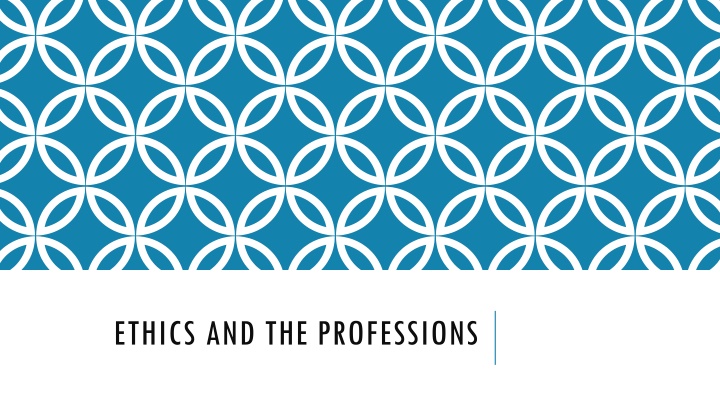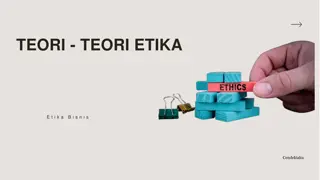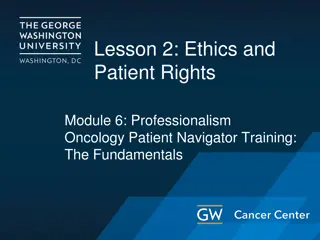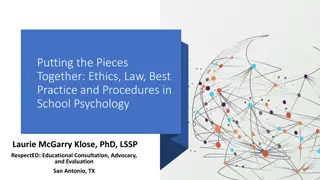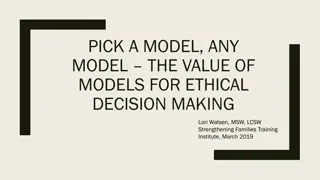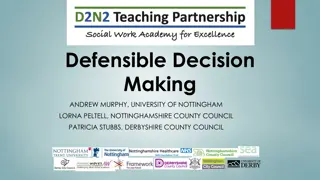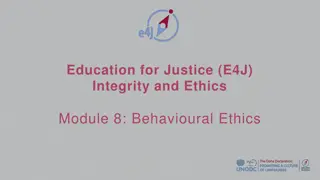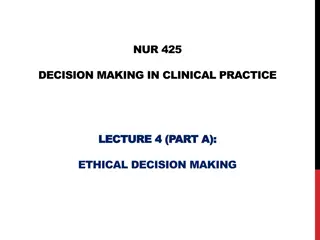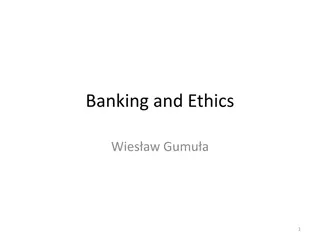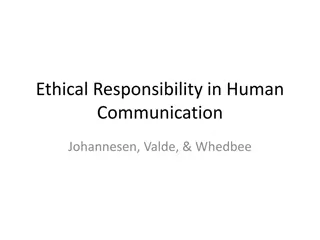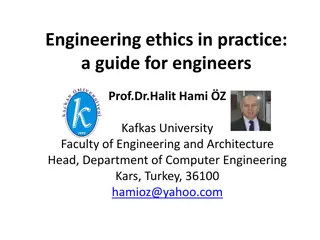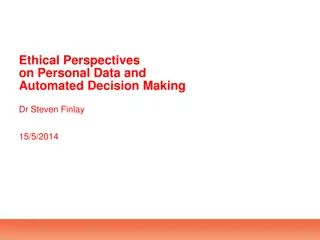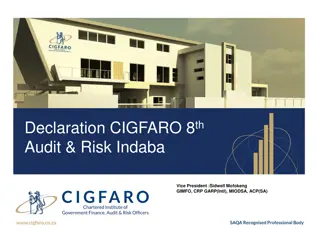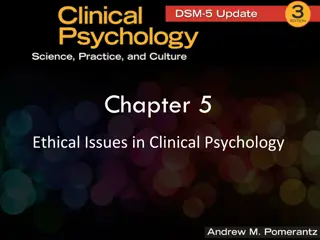Professional Ethical Decision Making and Evolution
Exploring ethical issues in professional decision-making, the impact of global computing, mechanisms for ethical choices, stages of whistleblowing, strengths/weaknesses of professional codes, evolution of professions, professional requirements, codes governing human actions, and the pillars of professionalism.
Download Presentation

Please find below an Image/Link to download the presentation.
The content on the website is provided AS IS for your information and personal use only. It may not be sold, licensed, or shared on other websites without obtaining consent from the author.If you encounter any issues during the download, it is possible that the publisher has removed the file from their server.
You are allowed to download the files provided on this website for personal or commercial use, subject to the condition that they are used lawfully. All files are the property of their respective owners.
The content on the website is provided AS IS for your information and personal use only. It may not be sold, licensed, or shared on other websites without obtaining consent from the author.
E N D
Presentation Transcript
Identify ethical issues that arise in professional decision making and determine how to address them Analyze global computing issues that in fluence professional decision making ETHICS AND THE PROFESSIONS Describe the mechanisms that typically exist for day- to-day ethical decision making Identify progressive stages in a whistle-blowing incident Specify the strengths and weaknesses of relevant professional codes as expressions of professionalism and guides to decision making
EVOLUTION OF PROFESSIONS Profession refers to a commitment formally professed by a person to become a member of that profession, and has professed the commitment Over the years, the term profession and its requirements for membership evolved into two categories: Learned professions, which required individuals with a deep knowledge of the profession acquired through years of formal education, and Common professions, which required the individuals to be noblemen who in theory did not really need to work for a living: they were liberated from the need to work, but ought to learn the profession anyway.
REQUIREMENTS OF A PROFESSIONAL There are three basic professional requirements, and over the years as the professions evolved, these three elements have taken different forms, A set of highly developed skills and deep knowledge of the domain Autonomy Observance of a code of conduct The professional code A personal code The institutional code The community code
CODES GOVERNING HUMAN ACTIONS
PILLARS OF PROFESSIONALISM Professionalism is supported by four pillars: Commitment Integrity Responsibility Accountability
PILLARS OF PROFESSIONALISM COMMITMENT The person making the commitment must do so willingly without duress The person responsible must try to meet the commitment , even if help is needed There must be agreement on what is to be done, by whom, and when The commitment must be openly and publicly stated The commitment must not be made easily Prior to the committed date, if it is clear it cannot be met, advance notice must be given and a new commitment negotiated
PILLARS OF PROFESSIONALISM INTEGRITY means a state of undivided loyalty to self-belief. It is honesty, uncompromising self-value, and incorruptible. The word integrity comes from the Latin word integratas , which means entire, undivided, or whole To stay undivided in one s beliefs professionally requires three maxims of integrity, namely: vision love of what one is doing and commitment to what one has to do.
PILLARS OF PROFESSIONALISM RESPONSIBILITY Deals with roles, tasks, and actions and their ensuing consequences. When individuals choose a lifestyle implied in a career, they choose and must accept the package of responsibilities that go with that lifestyle, Responsibilities of a Professional as a Provider Service Responsibilities Product Responsibilities Consequential Responsibilities
PILLARS OF PROFESSIONALISM ACCOUNTABILITY Accountability is the obligation to answer for the execution of one s assigned responsibilities This process involves the cycle of 1) setting measurable goals, 2) planning what needs to be done to meet those goals, 3) reporting progress towards goals, 4) evaluating the reports, and 5) using that feedback to make improvements Accountability involves these three key elements, A set of outcome measures that reliably and objectively evaluate performance A set of performance standards defined in terms of these outcome measures A set of incentives for meeting the standards and/or penalties for failing to meet them
MAKING OF AN ETHICAL PROFESSIONAL: EDUCATION & LICENSING A deep knowledge of the profession acquired through formal education or to be intrinsically of a gentleman s calling , willing to hold a higher ethical standard In order to continue to uphold these essential requirements in both professions, three items that encourage, maintain, and improve the higher ethical standard are as follows: formal education licensing professional codes of conduct Professionals must follow a specific process to meet and maintain those professional requirements
PROFESSIONAL CODES OF CONDUCT The primary purpose of professional codes of conduct is to promote the public image of the profession by specifying and enforcing the ethical behavior expected from its members. In order for professional codes of conduct to be effective, a profession must institute a system of enforcement, reporting, hearing procedures, sanctions, and appeals. Codes without such systems in place are completely ineffective.
Accordingly, professional codes consist of the following areas: Moral and legal standards Professional client relationship Client advocacy Professional public relationships Sanction mechanics Confidentiality Assessment Compliance Competence Certified professional credentials for those professions that use certification PROFESSIONAL CODES OF CONDUCT
ENFORCEMENT Professions with enforceable codes have fewer discipline problems among their members than those with no codes or those with codes but without enforcement mechanisms There are various techniques of enforcement, most of them with no civil authority. The most widely used are professional ethics boards, standing committees, or review boards charged with the following: Drawing up the codes of ethics for the profession if none exist Revising codes if and when necessary Conducting education campaigns at the membership level Distributing copies of the codes to every member Developing disciplinary procedures Receiving complaints, conducting hearings, counseling members, and sanctioning members found guilty Promoting the image of the profession
REPORTING OF GRIEVANCES There are two main reporting procedures: 1) The typical organizational route in which a complaint is reported first to the local chapters if it exists. The complaint then makes its way to the top, usually to the national ethics committee 2) The short-circuit procedure in which reporting can be done at any level, and then from there a complaint is forwarded all the way to the top
HEARING PROCEDURES Hearing proceedings are difficult to generalize about because of the many factors the hearing depends on. for example: The nature, the financial standing, and the structure of the profession. The kind of enforcement procedures being used. and the penalty to be imposed.
SANCTIONS If a hearing committee decides that a member is guilty of the offenses charged, then the committee must come up with sanctions to fit the violations committed by the member The committee may decide to recommend any one or a combination of the following: probation revocation of certification request for resignation suspension from the profession at the member s expense
APPEALS A profession must have an appeal process on the books for the sanctioned professional who is not satisfied with either the ruling of the committee or the penalty imposed Such guidelines should state clearly the procedure for appeals: how the appeal instrument is to be handled, who deals with the appeals, and the maximum amount of time an individual has between the time he or she receives a judgment and the filling of the appeal
MORAL DILEMMAS, DECISION MAKING & TECHNOLOGY The process of decision making is complex: It resembles a mathematical mapping of input parameters into output decisions The input parameters in the decision-making process are premises The mapping uses these values along with the premises to create an output, which is the decision The mapping function takes these premises together with the values and outputs a logical decision Dilemmas in decision making are caused by one questioning the values attached to one s premises as inputs to the decision being made One s scaling of values to the inputs may be influenced by a number of factors such as advances in technology and incomplete or misleading information
Dilemmas are usually caused by advances in technology Computer technology in particular has created more muddles in the decision-making process than in any other technology Advances in computer technology create a multitude of possibilities that never existed before Such possibilities present professionals with myriad temptations ADVANCES IN TECHNOLOGY
MAKING GOOD USE OF TECHNOLOGY How can we use technology in a nondestructive way to advance human society? Technology has placed at our disposal a multitude of possibilities, that are shrouding our daily value-based decision making in confusion and doubt Doubts are created because gaps in reasoning between right and wrong has been muddled up because of the many possibilities
MAKING GOOD USE OF TECHNOLOGY An appropriate response to this confusion of reasoning is multifaceted and may include the following solutions: Formulate new laws to strengthen our basic set of values, which are being rendered irrelevant by technology Construct a new moral and ethical conceptual framework in which the new laws can be applied successfully Launch a massive education campaign to make society aware of the changing environment and the impact such an environment is having on our basic values Nations and communities must have a regulated technology policy. Technology without a policy is dangerous technology
A NEW CONCEPTUAL MORAL FRAMEWORK New technologies in communication have resulted in demographical tidal waves for the global societies The movement of people and goods between nations, societies and the Internet are slowly creating a new global society with serious social and moral characteristics This globalization, along with the plummeting prices of computers and other Internet-accessing devices, had ignited a growing realization and fear, especially among religious and civic leaders, moralists, and parents, that society is becoming morally loose and citizens are forgetting what it is to be human Of immediate concern to these groups and many others is that a common morality is needed As societies become diverse, the need for a common moral framework as a standard for preserving decency and effectively reversing the trend of skyrocketing moral decadence and combating crimes becomes most urgent
PROFESSIONALISM AND ETHICAL RESPONSIBILITIES Whistle-Blowing The term whistle-blowing gives the impression of an act of seeking public attention The purpose of whistle-blowing in the workplace and the goal of a whistleblower is calling to public attention, including especially to that of a higher authority such as a government, what is considered an illegal or mismanaged act Different whistle-blowing methods have been used for years, ranging from traditional ones to more modern computer-aided ones
PROFESSIONALISM AND ETHICAL RESPONSIBILITIES Harassment and Discrimination Harassment is to verbally or physically create an environment that is hostile, intimidating, offensive, severe, pervasive, or abusive based on a number of parameters including one s race, religion, national origin, age, disability, political affiliation, marital status, citizenship, or physical appearance Discrimination on the other hand is a process of making decisions that negatively affect an individual, such as denial of a service, based wholly, or partly, upon the real or perceived facts of one s race, religion, national origin Awareness and Prevention can effectively fight against harassment and discrimination
PROFESSIONALISM AND ETHICAL RESPONSIBILITIES Ethical and Moral Implications Even people with high moral standards can be prevented from doing what is morally right because of the privileges, rights, and freedoms they stand to lose within the organization if they become known
